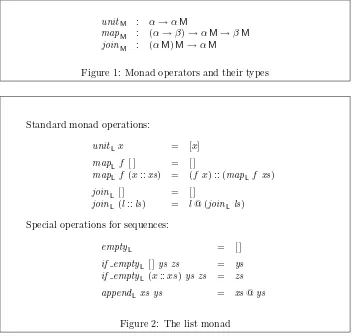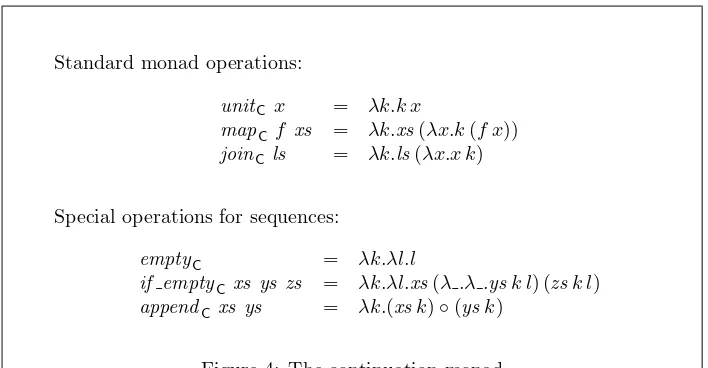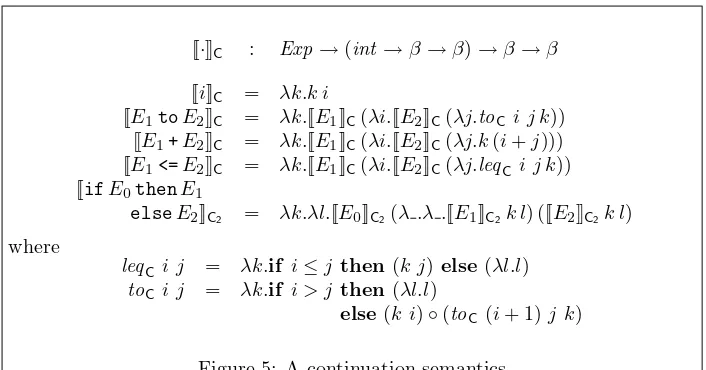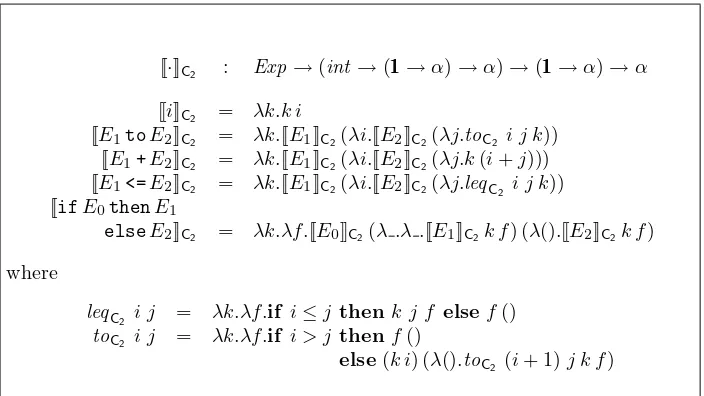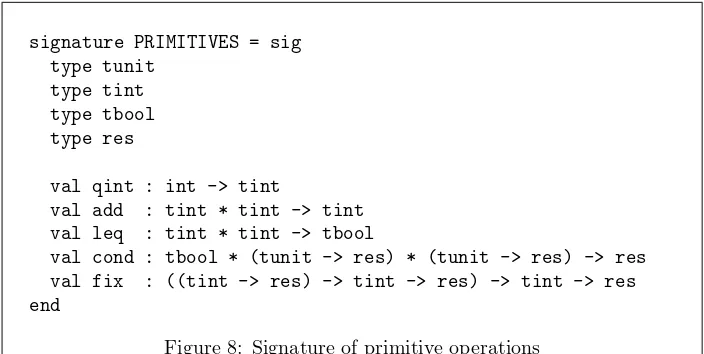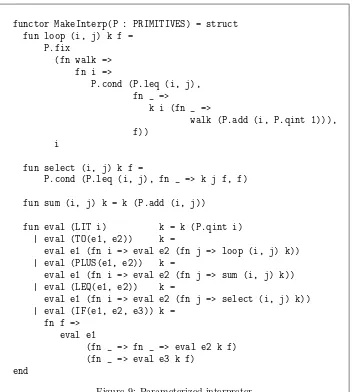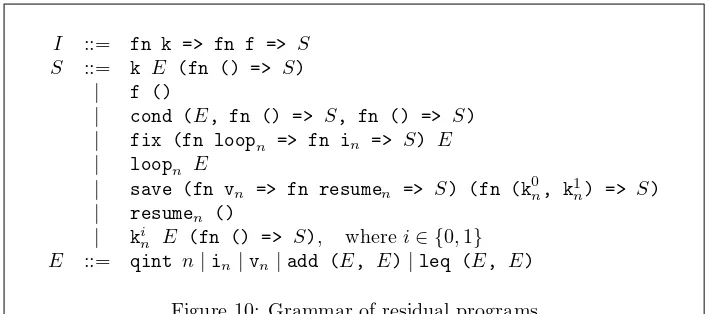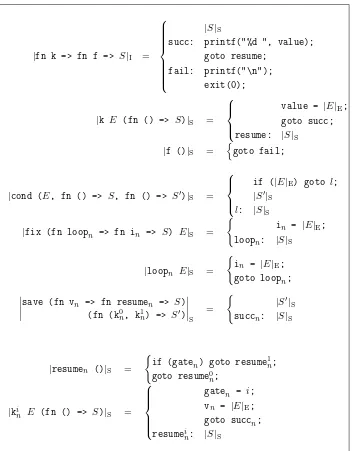B
Basic Research in Computer Science
Copyright c
2001,
Olivier Danvy & Bernd Grobauer & Morten
Rhiger.
BRICS, Department of Computer Science
University of Aarhus. All rights reserved.
Reproduction of all or part of this work
is permitted for educational or research use
on condition that this copyright notice is
included in any copy.
See back inner page for a list of recent BRICS Report Series publications.
Copies may be obtained by contacting:
BRICS
Department of Computer Science
University of Aarhus
Ny Munkegade, building 540
DK–8000 Aarhus C
Denmark
Telephone: +45 8942 3360
Telefax:
+45 8942 3255
Internet:
[email protected]
BRICS publications are in general accessible through the World Wide
Web and anonymous FTP through these URLs:
http://www.brics.dk
ftp://ftp.brics.dk
A Unifying Approach
to Goal-Directed Evaluation
∗
Olivier Danvy, Bernd Grobauer, and Morten Rhiger
BRICS
†Department of Computer Science
University of Aarhus
‡July 13, 2001
Abstract
Goal-directed evaluation, as embodied in Icon and Snobol, is built on the notions of backtracking and of generating successive results, and therefore it has always been something of a challenge to specify and im-plement. In this article, we address this challenge using computational monads and partial evaluation.
We consider a subset of Icon and we specify it with a monadic se-mantics and a list monad. We then consider a spectrum of monads that also fit the bill, and we relate them to each other. For example, we de-rive a continuation monad as a Church encoding of the list monad. The resulting semantics coincides with Gudeman’s continuation semantics of Icon.
We then compile Icon programs by specializing their interpreter (i.e., by using the first Futamura projection), using type-directed partial eval-uation. Through various back ends, including a run-time code generator, we generate ML code, C code, and OCaml byte code. Binding-time anal-ysis and partial evaluation of the continuation-based interpreter automat-ically give rise to C programs that coincide with the result of Proebsting’s optimized compiler.
∗To appear in New Generation Computing, Vol. 20 No. 1, Nov. 2001. A preliminary version
is available in the proceedings of SAIG 2001.
†Basic Research in Computer Science (www.brics.dk),
funded by the Danish National Research Foundation.
‡Ny Munkegade, Building 540, DK-8000 Aarhus C, Denmark.
E-mail:{danvy,grobauer,mrhiger}@brics.dk
Contents
1 Introduction 3
2 Semantics of a Subset of Icon 4
2.1 A subset of the Icon programming language . . . 4
2.2 Monads and semantics . . . 4
2.3 A monad of sequences . . . 6
2.4 A monadic semantics . . . 6
2.5 A spectrum of semantics . . . 7
2.5.1 A list-based interpreter . . . 7
2.5.2 A stream-based interpreter . . . 7
2.5.3 A continuation-based interpreter . . . 7
2.5.4 An interpreter with explicit success and failure continuations 8 2.6 Correctness . . . 10
2.7 Conclusion . . . 11
3 Semantics-Directed Compilation 11 3.1 Type-directed partial evaluation . . . 12
3.1.1 Specializing Icon terms using type-directed partial evalu-ation . . . 12
3.1.2 Avoiding code duplication . . . 14
3.2 Generating C programs . . . 15
3.3 Generating byte code . . . 19
3.3.1 Run-time code generation in OCaml . . . 19
3.3.2 Compiling flow charts into OCaml byte code . . . 20
3.4 Conclusion . . . 20
4 Conclusions and Issues 20
List of Figures
1 Monad operators and their types . . . 52 The list monad . . . 5
3 Monadic semantics for a subset of Icon . . . 6
4 The continuation monad . . . 8
5 A continuation semantics . . . 9
6 A semantics with success and failure continuations . . . 10
7 The abstract syntax of Icon terms . . . 12
8 Signature of primitive operations . . . 13
9 Parameterized interpreter . . . 14
10 Grammar of residual programs . . . 17
11 Translating residual programs into C (Statements) . . . 18
1
Introduction
Goal-directed languages combine expressions that can yield multiple results through backtracking. Results are generated one at a time: an expression can either succeed and generate a result, or fail. If an expression fails, control is passed to a previous expression to generate the next result, if any. If so, control is passed back to the original expression in order to try whether it can succeed this time. Goal-directed programming specifies the order in which subexpres-sions are retried, thus providing the programmer with a succint and powerful control-flow mechanism. A well-known goal-directed language is Icon [11].
Backtracking as a language feature complicates both semantics and imple-mentation. Gudeman [13] gives a continuation semantics of a goal-directed language; continuations have also been used in implementations of languages with control structures similar to those of goal-directed evaluation, such as Pro-log [3, 15, 30]. Proebsting and Townsend, the implementors of an Icon compiler in Java, observe that continuations can be compiled into efficient code [1, 14], but nevertheless dismiss them because “[they] are notoriously difficult to under-stand, and few target languages directly support them” [23, p.38]. Instead, their compiler is based on a translation scheme proposed by Proebsting [22], which is based on the four-port model used for describing control flow in Prolog [2]. Icon expressions are translated to a flow-chart language with conditional, direct and indirect jumps using templates; a subsequent optimization which, amongst other things, reorders code and performs branch chaining, is necessary to pro-duce compact code. The reference implemention of Icon [12] compiles Icon into byte code; this byte code is then executed by an interpreter that controls the control flow by keeping a stack of expression frames.
In this article, we present a unified approach to goal-directed evaluation:
1. We consider a spectrum of semantics for a small goal-directed language. We relate them to each other by deriving semantics such as Gudeman’s [13] as instantiations of one generic semantics based on computational mon-ads [21]. This unified approach enables us to show the equivalence of different semantics simply and systematically. Furthermore, we are able to show strong conceptual links between different semantics: Continuation semantics can be derived from semantics based on lists or on streams of results by Church-encoding the lists or the streams, respectively.
2. We link semantics and implementation through semantics-directed compi-lation using partial evaluation [5, 17]. In particular, binding-time analysis guides us to extract templates from the specialized interpreters. These templates are similar to Proebsting’s, and through partial evaluation, they give rise to similar flow-chart programs, demonstrating that templates are not just a good idea—they are intrinsic to the semantics of Icon and can be provably derived.
semantics with various monads, relate the resulting semantics to each other, and present an equivalence proof for two of them. In Section 3 we describe semantics-directed compilation for a goal-semantics-directed language. Section 4 concludes.
2
Semantics of a Subset of Icon
An intuitive explanation of goal-directed evaluation can be given in terms of lists and list-manipulating functions. Consequently, after introducing the subset of Icon treated in this paper, we define a monadic semantics in terms of the list monad. We then show that also a stream monad and two different continuation monads can be used, and we give an example of how to prove equivalence of the resulting monads using a monad morphism.
2.1
A subset of the Icon programming language
We consider the following subset of Icon:
E::=i|E1 + E2|E1 to E2|E1 <= E2|if E1 then E2 else E3 Intuitively, an Icon term either fails or succeeds with a value. If it succeeds, then subsequently it can be resumed, in which case it will again either succeed or fail. This process ends when the expression fails. Informally,isucceeds with the value i; E1 + E2 succeeds with the sum of the sub-expressions; E1 to E2 (called a
generator) succeeds with the value ofE1and each subsequent resumption yields the rest of the integers up to the value ofE2, at which point it fails;E1 <= E2 succeeds with the value ofE2if it is larger than the valueE1, otherwise it fails;
if E1 then E2 else E3 produces the results ofE2 ifE1 succeeds, otherwise it produces the results ofE3.
Generators can be nested. For example, the Icon term4 to (5 to 7) gener-ates the result of the expressions4 to 5,4 to 6, and4 to 7and concatenates the results.
In a functional language such as Scheme, ML or Haskell, we can achieve the effect of Icon terms using the functions map and concat. For example, if we define
fun to i j = if i<=j then i::(to (i+1) j) else nil
in ML, then evaluatingconcat (map (to 4) (to 5 7))yields[4, 5, 4, 5, 6, 4, 5, 6, 7]which is the list of the integers produced by the Icon term4 to (5 to 7).
2.2
Monads and semantics
unitM : α→αM
mapM : (α→β)→αM→βM
joinM : (αM)M→αM
Figure 1: Monad operators and their types
Standard monad operations:
unitL x = [x]
mapL f [ ] = [ ]
mapL f (x::xs) = (f x) :: (mapL f xs)
joinL [ ] = [ ]
joinL (l::ls) = l@ (joinL ls)
Special operations for sequences:
emptyL = [ ]
if emptyL [ ]ys zs = ys
if emptyL (x::xs)ys zs = zs
appendLxs ys = xs@ys
Figure 2: The list monad
proofs between semantics arising from instantiation with different monads can be conducted in a modular way, using the concept of a monad morphism [28].
Monads can also be used to structure functional programs [29]. In terms of programming languages, a monadM is described by a unary type constructor M and three operations unitM, mapM and joinM with types as displayed in
Figure 1. For these operations, the so-called monad laws have to hold.
In Section 2.4 we give a denotational semantics of the goal-directed language described in Section 2.1. Anticipating semantics-directed compilation by partial evaluation, we describe the semantics in terms of ML, in effect defining an interpreter. The semantics [[·]]M : Exp→intMis parameterized over a monad
[[·]]M : Exp→intM
[[i]]M = unitMi
[[E1toE2]]M = bind2M (λxy.toM x y) [[E1]]M [[E2]]M
[[E1+E2]]M = bind2M (λxy.unitM (x+y)) [[E1]]M [[E2]]M
[[E1<=E2]]M = bind2M (λxy.leqMx y) [[E1]]M[[E2]]M
[[ifE0thenE1
elseE2]]M = if emptyM [[E0]]M[[E1]]M[[E2]]M
where
bind2Mf xs ys = joinM(mapM(λx.joinM(mapM (f x)ys))xs)
leqMi j = if i≤j thenunitM j elseemptyM
toMi j = if i > j thenemptyM
else appendM (unitMi) (toM(i+ 1) j)
Figure 3: Monadic semantics for a subset of Icon
2.3
A monad of sequences
In order to handle sequences, some structure is needed in addition to the three generic monad operations displayed in Figure 1. We add three operations:
emptyM : αM
if emptyM : αM→βM→βM→βM
appendM : αM→αM→αM
Here, emptyM stands for the empty sequence; if emptyM is a discriminator
function that, given a sequence and two additional inputs, returns the first input if the sequence is empty, and returns the second input otherwise;appendM
appends two sequences.
A straightforward instance of a monad of sequences is the list monad L,
which is displayed in Figure 2; for lists, “join” is sometimes also called “flatten” or, in ML, “concat”.
2.4
A monadic semantics
A monadic semantics of the goal-directed language described in Section 2.1. is given in Figure 3. We explain the semantics in terms of the list monad. A literal iis interpreted as an expression that yields exactly one result; consequently,iis mapped into the singleton list [i] usingunit. The semantics ofto,+and<=are given in terms ofbind2 and a function of typeint→int →intlist. The type of
functionbind2L is
i.e., it takes two lists containing values of typeαandβ, and a function mapping α×βinto a list of values of typeγ. The effect of the definition ofbind2Lf xs ys
is (1) to mapf xoverys for eachxinxs and (2) to flatten the resulting list of lists. Both steps can be found in the example at the end of Section 2.1 of how the effect of goal-directed evaluation can be achieved in ML using lists.
2.5
A spectrum of semantics
In the following, we describe four possible instantiations of the semantics given in Figure 3. Because a semantics corresponds directly to an interpreter, we thus create four different interpreters.
2.5.1 A list-based interpreter
Instantiating the semantics with the list monad from Figure 2 yields a list-based interpreter. In an eager language such as ML, a list-based interpreter always computes all results. Such behavior may not be desirable in a situation where only the first result is of interest (or, for that matter, whether there exists a result): Consider for example the conditional, which examines whether a given expression yields at least one result or fails. An alternative is to use laziness.
2.5.2 A stream-based interpreter
Implementing the list monad from Figure 2 in a lazy language results in a monad of (finite) lazy lists; the corresponding interpreter generates one result at a time. In an eager language, this effect can be achieved by explicitly implementing a data type of streams, i.e., finite lists built lazily: a thunk is used to delay computation.
αstream ≡ End|More of (α×(111→αstream))
The definition of the corresponding monad operations is straightforward.
2.5.3 A continuation-based interpreter
Gudeman [13] gives a continuation-based semantics of a goal-directed language. We can derive this semantics by instantiating our monadic semantics with the continuation monadCas defined in Figure 4. The type-constructorαCof the
continuation monad is defined as (α→R)→R, whereR is called the answer type of the continuation.
A conceptual link between the list monad and the continuation monad with answer type βlist → βlist can be made through a Church encoding [4] of the
higher-order representation of lists proposed by Hughes [16]. Hughes observed that when constructing the partially applied concatenation functionλys.xs@ys
Standard monad operations:
unitC x = λk.k x
mapC f xs = λk.xs(λx.k(f x))
joinC ls = λk.ls(λx.x k)
Special operations for sequences:
emptyC = λk.λl.l
if emptyC xs ys zs = λk.λl.xs(λ .λ .ysk l) (zsk l)
appendC xs ys = λk.(xsk)◦(ysk)
Figure 4: The continuation monad
represented by a partially applied cons function:
nil = λys.ys cons x = λys.x::ys
Church-encoding a data types means abstracting over selector functions, in this case “ :: ”:
nil = λsc.λys.ys
cons x = λsc.λys.scxys
The resulting representation of lists can be typed as (α→β →β)→β →β,
which indeed corresponds toαCwith answer type β→β. Notice thatnil and
cons for this list representation yieldemptyCandunitC, respectively. Similarly,
the remaining monad operations correspond to the usual list operations. Figure 5 displays the definition of [[·]]C where all monad operations have been
inlined and the resulting expressionsβ-reduced.
2.5.4 An interpreter with explicit success and failure continuations
A tail-recursive implementation of a continuation-based interpreter for Icon uses explicit success and failure continuations. The result of interpreting an Icon expression then has type
(int→(111→α)→α)→(111→α)→α,
[[·]]C : Exp→(int →β→β)→β→β
[[i]]C = λk.k i
[[E1toE2]]C = λk.[[E1]]C(λi.[[E2]]C(λj.toCi j k))
[[E1+E2]]C = λk.[[E1]]C(λi.[[E2]]C(λj.k(i+j)))
[[E1<=E2]]C = λk.[[E1]]C(λi.[[E2]]C(λj.leqC i j k))
[[ifE0thenE1
elseE2]]C2 = λk.λl.[[E0]]C2(λ .λ .[[E1]]C2k l) ([[E2]]C2k l)
where
leqC i j = λk.if i≤j then(k j)else(λl.l)
toC i j = λk.if i > j then(λl.l)
else(k i)◦(toC (i+ 1)j k)
Figure 5: A continuation semantics
its failure continuation to generate more results. The corresponding continu-ation monadC2 has the same standard monad operations as the continuation
monad displayed in Figure 4, and the sequence operations
emptyC2 = λk.λf.f()
if emptyC2 xs ys zs = λk.λf.xs(λ .λ .zsk f) (λ().ysk f)
appendC2 xs ys = λk.λf.(xsk)(λ().ysk f)
Just as the continuation monad from Figure 4 can be conceptually linked to the list monad, the present continuation monad can be linked to the stream monad by a Church encoding of the data type of streams:
end = λsm.λse.se()
morexxs = λsm.λse.smxxs
The fact that the second component in a stream is a thunk suggests one to give the selector functionsmthe typeint →(111→α)→β; the resulting type forend
andmorexxs is then
(int →(111→α)→β)→(111→β)→β.
Choosing α as the result type of the selector functions yields the type of a continuation monad with answer type (111→α)→α.
The interpreter defined by the semantics [[·]]C2 is the starting point of the
semantics-directed compilation described in Section 3. Figure 6 displays the definition of [[·]]C2where all monad operations have been inlined and the resulting
expressionsβ-reduced. Because the basic monad operations ofC2are the same
as those ofC, the semantics based onC2and Conly differ in the definitions of
[[·]]C2 : Exp→(int →(111→α)→α)→(111→α)→α
[[i]]C2 = λk.k i
[[E1toE2]]C2 = λk.[[E1]]C2(λi.[[E2]]C2(λj.toC2 i j k))
[[E1+E2]]C2 = λk.[[E1]]C2(λi.[[E2]]C2(λj.k(i+j)))
[[E1<=E2]]C2 = λk.[[E1]]C2(λi.[[E2]]C2(λj.leqC2 i j k))
[[ifE0thenE1
elseE2]]C2 = λk.λf.[[E0]]C2(λ .λ .[[E1]]C2k f) (λ().[[E2]]C2k f)
where
leqC2 i j = λk.λf.if i≤j thenk j f else f()
toC2 i j = λk.λf.if i > j thenf()
else(k i) (λ().toC2 (i+ 1) j k f)
Figure 6: A semantics with success and failure continuations
2.6
Correctness
So far, we have related the various semantics presented in Section 2.5 only con-ceptually. Because the four different interpreters presented in Section 2.5 were created by instantiating one parameterized semantics with different monads, a
formal correspondence proof can be conducted in a modular way building on the concept of a monad morphism [28].
Definition 1 (Monad morphism) If M and N are two monads, then h :
αM→αNis a monad morphismif it preserves the monad operations1
, i.e.,
h◦unitM = unitN
h◦mapMf = mapNf◦h
h◦joinM = joinN◦h◦mapMh
hemptyM = emptyN
h◦if emptyM = λxs.λys.λzs.if emptyN(hxs)(hys)(hzs)
h◦appendM = λxs.λys.appendN(hxs)(hys)
The following lemma shows that the semantics resulting from two different monad instantiations can be related by defining a monad morphism between the two sequence monads in question.
Lemma 2 Let MandNbe monads of sequences as specified in Section 2.3. If
h is a monad morphism from M to N, then (h[[E]]M) = [[E]]N for every Icon
expressionE.
Proof: By induction over the structure of E. A lemma to the effect that
h(toMi j) =toNi jis shown by induction overi−j fori≥j.
We use Lemma 2 to show that the list-based interpreter from Section 2.5.1 and the continuation-based interpreter from Section 2.5.3 always yield comparable results:
Proposition 3 Let show : αC→αLbe defined as
show f = f (λx.λxs.appendL (unitL x)xs)emptyL.
Then (show[[E]]C) = [[E]]L for all Icon expressionsE.
Proof: We show that (1)h : αL→αC, which is defined as
h[ ] = emptyC
h(x::xs) = appendC (unitC x) (hxs)
is a monad morphism fromLtoC, and (2) the function (show◦h) is the identity
function on lists. The proposition then follows immediately with Lemma 2.
2.7
Conclusion
Taking an intuitive list-based semantics for a subset of Icon as our starting point, we have defined a stream-based semantics and two continuation semantics. Be-cause our inital semantics is defined as the instantiation of a monadic semantics with a list monad, the other semantics can be defined through a stream monad and two different continuation monads, respectively. The modularity of the monadic semantics allows us to relate the semantics to each other by relat-ing the correspondrelat-ing monads, both conceptually and formally. To the best of our knowledge, the conceptual link between list-based monads and continuation monads via Church encoding has not been observed before.
It is known that continuations can be compiled into efficient code relatively easily [1, 14]; in the following section we show that partial evaluation is suffi-cient to generate effisuffi-cient code from the the continuation semantics derived in Section 2.5.4.
3
Semantics-Directed Compilation
The goal of partial evaluation is to specialize a source programp:S×D→R of two arguments to a fixed “static” argument s: S. The result is a residual programps : D →R that must yield the same result when applied to a
“dy-namic” argumentdas the original program applied to both the static and the dynamic arguments, i.e., [[ps(d)]] = [[p(s, d)]].
is a term in the domain ofpthenpsis a compiled version ofsrepresented in the
implementation language ofp. It is often possible to implement an interpreter in a functional language based on the denotational semantics.
Our starting point is a functional interpreter implementing the denotational semantics in Figure 6. The source language of the interpreter is shown in Fig-ure 7. In Section 3.1 we present the Icon interpreter written in ML. In Sec-tion 3.1, 3.2, and 3.3 we use type-directed partial evaluaSec-tion to specialize this interpreter to Icon terms yielding ML code, C code, and OCaml byte code as output. Other partial-evaluation techniques could be applied to yield essentially the same results.
structure Icon = struct datatype icon = LIT of int
| TO of icon * icon | PLUS of icon * icon | LEQ of icon * icon
| IF of icon * icon * icon end
Figure 7: The abstract syntax of Icon terms
3.1
Type-directed partial evaluation
We have used type-directed partial evaluation to compile Icon programs into ML. This is a standard exercise in semantics-directed compilation using type-directed partial evaluation [9].
Type-directed partial evaluation is an approach to off-line specialization of higher-order programs [8]. It uses a normalization function to map the (value of the) trivially specialized programλd.p(s, d) into the (text of the) target program
ps.
The input to type-directed partial evaluation is a binding-time separated pro-gram in which static and dynamic primitives are separated. When implemented in ML, the source program is conveniently wrapped in a functor parameterized over a structure of dynamic primitives. The functor can be instantiated with evaluating primitives (for running the source program) and with residualizing primitives (for specializing the source program).
3.1.1 Specializing Icon terms using type-directed partial evaluation
we let the partial evaluator produce functions that generate ML programs with meaningful variable names [8].
The parameterized interpreter is shown in Figure 9. The main functioneval
takes an Icon term and two continuations,k: tint→(tunit→ res)→ res
andf:tunit→res, and yields a result of typeres. We intend to specialize the interpreter to a static Icon term and keeping the continuation parameters
kand fdynamic. Consequently, residual programs are parameterized over two continuations. (If the continuations were also considered static then the residual programs would simply be the list of the generated integers.)
signature PRIMITIVES = sig type tunit
type tint type tbool type res
val qint : int -> tint
val add : tint * tint -> tint val leq : tint * tint -> tbool
val cond : tbool * (tunit -> res) * (tunit -> res) -> res val fix : ((tint -> res) -> tint -> res) -> tint -> res end
Figure 8: Signature of primitive operations
The output of type-directed partial evaluation is the text of the residual program. The residual program is in long beta-eta normal form, that is, it does not contain any beta redexes and it is fully eta-expanded with respect to its type.
Example 4 The following is the result of specializing the interpreter with re-spect to the Icon term10 + (4 to 7).
fn k => fn f => fix (fn loop0 =>
fn i0 =>
cond (leq (i0, qint 7),
fn () => k (add (qint 10, i0))
(fn () => loop0 (add (i0, qint 1))), fn () => f ()))
functor MakeInterp(P : PRIMITIVES) = struct fun loop (i, j) k f =
P.fix
(fn walk => fn i =>
P.cond (P.leq (i, j), fn _ =>
k i (fn _ =>
walk (P.add (i, P.qint 1))), f))
i
fun select (i, j) k f =
P.cond (P.leq (i, j), fn _ => k j f, f)
fun sum (i, j) k = k (P.add (i, j))
fun eval (LIT i) k = k (P.qint i) | eval (TO(e1, e2)) k =
eval e1 (fn i => eval e2 (fn j => loop (i, j) k)) | eval (PLUS(e1, e2)) k =
eval e1 (fn i => eval e2 (fn j => sum (i, j) k)) | eval (LEQ(e1, e2)) k =
eval e1 (fn i => eval e2 (fn j => select (i, j) k)) | eval (IF(e1, e2, e3)) k =
fn f => eval e1
(fn _ => fn _ => eval e2 k f) (fn _ => eval e3 k f)
end
Figure 9: Parameterized interpreter
3.1.2 Avoiding code duplication
The result of specializing the interpreter in Figure 9 may be exponentially large. This is due to the continuation parameterkbeing duplicated in the clause for
IF. For example, specializing the interpreter to the Icon term100 + (if 1 < 2 then 3 else 4)yields the following residual program in which the context
add(100, ·)occurs twice.
fn k => fn f =>
cond (leq (qint 1, qint 2),
Code duplication is a well-known problem in partial evaluation [17]. The equally well-known solution is to bind the continuation in the residual program, just before it is used. We introduce a new primitivesaveof two arguments,k
andg, which appliesgto two “copies” of the continuationk.
signature PRIMITIVES = sig ...
type succ = tint -> (tunit -> res) -> res val save : succ -> (succ * succ -> res) -> res end
The final clause of the interpreter is modified to save the continuation pa-rameter before it proceeds, as follows.
fun eval (LIT i) k = k (P.qint i) ...
| eval (IF(e1, e2, e3)) k = fn f =>
save k
(fn (k0, k1) => eval e1
(fn _ => fn _ => eval e2 k0 f) (fn _ => eval e3 k1 f))
Specializing this new interpreter to the Icon term from above yields the following residual program in which the contextadd(100, ·)occurs only once.
fn k => fn f => save (fn v0 =>
fn resume0 =>
k (add (qint 100, v0)) (fn () => resume0 ())) (fn (k0_0, k1_0) =>
cond (leq (qint 1, qint 2),
fn () => k0_0 (qint 3) (fn () => f ()), fn () => k1_0 (qint 4) (fn () => f ())))
Two copies of continuation parameterkare bound tok0 0andk1 0before the continuation is used (twice, in the body of the second lambda). In order just to prevent code duplication, passing one “copy” of the continuation parameter is actually enough. But the translation into C introduced in Section 3.2 uses the two differently named variables, in this case k0_0andk1_0, to determine the
IF-branch inside which a continuation is applied.
3.2
Generating C programs
Residual programs are not only in long beta-eta normal form. Their type
imposes further restrictions: A residual program must take two arguments, a success continuationk:tint→(tunit→res)→resand a failure continua-tionf:tunit→res, and it must produce a value of typeres. When we also consider the types of the primitives that may occur in residual programs we see that values of typerescan only be a result of
• applying the success continuationkto an integern and function of type
tunit→res;
• applying the failure continuationf;
• applying the primitivecondto a boolean and two functions of typetunit→
res;
• applying the primitivefixto a function of two arguments,loopn:tint→
resandin :tint, and an integer;
• (inside a function passed tofix) applying the functionloopnto an integer;
• applying the primitivesaveto two arguments, the first being a function of two arguments,vn :tintandresumen:tunit→res, and the second
being a function of a pair of arguments,k0n andk
1
n, each of typetint→
(tunit→res)→res;
• (inside the first function passed to save) applying the functionresumen;
or
• (inside the second function passed tosave) applying one of the functions
k0
n ork
1
n to an integer and a function of typetunit→res.
A similar analysis applies to values of type tint: they can only arise from evaluating an integern, a variablein, or a variablevn or from applyingaddto
two argument of typetint. As a result, we observe that the residual programs of specializing the Icon interpreter using type-directed partial evaluation are restricted to the grammar in Figure 10. (The restriction that the variables
loopn,in,vn, andresumen each must occur inside a function that binds them
cannot be expressed using a context-free grammar. This is not a problem for our development.) We have expressed the grammar as an ML datatype and used this datatype to represent the output from type-directed partial evaluation. Thus, we have essentially used the type system of ML as a theorem prover to show the following lemma.
Lemma 5 The residual program generated from applying type-directed partial evaluation to the interpreter in Figure 9 can be generated by the grammar in Figure 10.
I ::= fn k => fn f => S S ::= k E (fn () => S)
| f ()
| cond (E, fn () => S, fn () => S)
| fix (fn loopn => fn in => S) E
| loopn E
| save (fn vn => fn resumen => S) (fn (k
0
n, k
1
n) => S)
| resumen ()
| ki
n E (fn () => S), wherei∈ {0,1}
E ::= qint n|in|vn |add (E, E)|leq (E, E)
Figure 10: Grammar of residual programs
The simple structure of output programs allows them to be viewed as pro-grams of a flow-chart language. We choose C as a concrete example of such a language. Figure 11 and 12 show the translation from residual programs to C programs.
The translation replaces function calls with jumps. Except for the call to
resumen (which only occurs as the result of compiling if-statements), the name
of a function uniquely determines the corresponding label to jump to. Jumps to
resumen can end up in two different places corresponding to the two copies of
the continuation. We use a boolean variablegaten to distinguish between the
two possible destinations. Calls toloopn and kn pass arguments. The names
of the formal parameters are known (in and vn, respectively) and therefore
arguments are passed by assigning the variable before the jump.
In each translation of a conditional a new labell must be generated. The entire translated term must be wrapped in a context that defines the labelssucc
andfail(corresponding to the initial continuations). The statements following the labelsuccare allowed to jump toresume. The translation in Figure 11 and 12 generates a C program that successively prints the produced integers one by one. A lemma to the effect that the translation from residual ML programs into C is semantics preserving would require giving semantics to C and to the subset of ML presented in Figure 10 and then showing equivalence.
Example 6 Consider again the Icon term10 + (4 to 7)from Example 4. It is translated into the following C program.
i0 = 4;
loop0: if (i0 <= 7) goto L0; goto fail;
|fn k => fn f => S|I =
|qint n|E = n
|in|E = in
|vn|E = vn
|add (E, E′)|E = |E|E + |E′|E
|leq (E, E′)|E = |E|E <= |E′|E
Figure 12: Translating residual programs into C (Expressions)
resume: i0 = i0 + 1; goto loop0;
succ: printf("%d ", value); goto resume;
fail: printf("\n"); exit(0);
The C target programs corresponds to the target programs of Proebsting’s optimized template-based compiler [22]. In effect, we are automatically gener-ating flow-chart programs from the denotation of an Icon term.
3.3
Generating byte code
In the previous two sections we have developed two compilers for Icon terms, one that generates ML programs and one that generates flow-chart programs. In this section we unify the two by composing the first compiler with the third author’s automatic run-time code generation system for OCaml [25] and by composing the second compiler with a hand-written compiler from flow charts into OCaml byte code.
3.3.1 Run-time code generation in OCaml
Run-time code generation for OCaml works by a deforested composition of tra-ditional type-directed partial evaluation with a compiler into OCaml byte code. Deforestation is a standard improvement in run-time code generation [6, 19, 26]. As such, it removes the need to manipulate the text of residual programs at spe-cialization time. As a result, instead of generating ML terms, run-time code gen-eration allows type-directed partial evaluation to directly generate executable OCaml byte code.
3.3.2 Compiling flow charts into OCaml byte code
We have modified the translation in Figure 11 and 12 to produce OCaml byte-code instructions instead of C programs. The result is an embedding of Icon into OCaml.
Using this compiler,10 + (4 to 7)yields 36 byte-code instructions in which functions are implemented as labelled blocks and calls are implemented as an assignment (if an argument is passed) followed by a jump. This style of target code was promoted by Steele in the first compiler for Scheme [27].
3.4
Conclusion
Translating the continuation-based denotational semantics into an interpreter written in ML and using type-directed partial evaluation enables a standard semantics-directed compilation from Icon terms into ML. A further compilation of residual programs into C yields flow-chart programs corresponding to those produced by Proebsting’s Icon compiler [22].
4
Conclusions and Issues
Observing that the list monad provides the kind of backtracking embodied in Icon, we have specified a semantics of Icon that is parameterized by this monad. We have then considered alternative monads and proven that they also provide a fitting semantics for Icon. Inlining the continuation monad, in particular, yields Gudeman’s continuation semantics [13].
Using partial evaluation, we have then specialized these interpreters with respect to Icon programs, thereby compiling these programs using the first Fu-tamura projection. We used a combination of type-directed partial evaluation and code generation, either to ML, to C, or to OCaml byte code. Generating code for C, in particular, yields results similar to Proebsting’s compiler [22].
Gudeman [13] shows that a continuation semantics can also deal with addi-tional control structures and state; we do not expect any difficulties with scaling up the code-generation accordingly. The monad of lists, on the other hand, does not offer enough structure to deal, e.g., with state. It should be possible, how-ever, to create a rich enough monad by combining the list monad with other monads such as the state monad [10, 18].
It is our observation that the traditional (in partial evaluation) generaliza-tion of the success continuageneraliza-tion avoids the code duplicageneraliza-tion that Proebsting presents as problematic in his own compiler. We are also studying the results of defunctionalizing the continuations, `a la Reynolds [24], to obtain stack-based specifications and the corresponding run-time architectures.
References
[1] Andrew W. Appel. Compiling with Continuations. Cambridge University Press, New York, 1992.
[2] Lawrence Byrd. Understanding the control of Prolog programs. Technical Report 151, University of Edinburgh, 1980.
[3] Mats Carlsson. On implementing Prolog in functional programming. New Generation Computing, 2(4):347–359, 1984.
[4] Alonzo Church. The Calculi of Lambda-Conversion. Princeton University Press, 1941.
[5] Charles Consel and Olivier Danvy. Tutorial notes on partial evalua-tion. In Susan L. Graham, editor, Proceedings of the Twentieth Annual ACM Symposium on Principles of Programming Languages, pages 493–501, Charleston, South Carolina, January 1993. ACM Press.
[6] Charles Consel and Fran¸cois No¨el. A general approach for run-time spe-cialization and its application to C. In Guy L. Steele, editor,Proceedings of the Twenty-Third Annual ACM Symposium on Principles of Programming Languages, pages 145–156, St. Petersburg Beach, Florida, January 1996. ACM Press.
[7] Ron K. Cytron, editor. Proceedings of the ACM SIGPLAN’97 Confer-ence on Programming Languages Design and Implementation, SIGPLAN Notices, Vol. 32, No 5, Las Vegas, Nevada, June 1997. ACM Press. [8] Olivier Danvy. Type-directed partial evaluation. In John Hatcliff,
Tor-ben Æ. Mogensen, and Peter Thiemann, editors,Partial Evaluation – Prac-tice and Theory; Proceedings of the 1998 DIKU Summer School, number 1706 in Lecture Notes in Computer Science, pages 367–411, Copenhagen, Denmark, July 1998. Springer-Verlag.
[9] Olivier Danvy and Ren´e Vestergaard. Semantics-based compiling: A case study in type-directed partial evaluation. In Herbert Kuchen and Doaitse Swierstra, editors,Eighth International Symposium on Programming Lan-guage Implementation and Logic Programming, number 1140 in Lecture Notes in Computer Science, pages 182–197, Aachen, Germany, September 1996. Springer-Verlag. Extended version available as the technical report BRICS-RS-96-13.
[10] Andrzej Filinski. Representing layered monads. In Alex Aiken, editor,
Proceedings of the Twenty-Sixth Annual ACM Symposium on Principles of Programming Languages, pages 175–188, San Antonio, Texas, January 1999. ACM Press.
[12] Ralph E. Griswold and Madge T. Griswold. The Implementation of the Icon Programming Language. Princeton University Press, 1986.
[13] David A. Gudeman. Denotational semantics of a goal-directed language.
ACM Transactions on Programming Languages and Systems, 1992.
[14] Robert Hieb, R. Kent Dybvig, and Carl Bruggeman. Representing control in the presence of first-class continuations. In Bernard Lang, editor, Pro-ceedings of the ACM SIGPLAN’90 Conference on Programming Languages Design and Implementation, SIGPLAN Notices, Vol. 25, No 6, pages 66–77, White Plains, New York, June 1990. ACM Press.
[15] Ralf Hinze. Prological features in a functional setting—axioms and implementations. In Masahiko Sato and Yoshihito Toyama, editors,
Third Fuji International Symposium on Functional and Logic Programming (FLOPS’98), pages 98–122, Kyoto, Japan, April 1998. World Scientific. [16] John Hughes. A novel representation of lists and its application to the
function “reverse”. Information Processing Letters, 22(3):141–144, 1986. [17] Neil D. Jones, Carsten K. Gomard, and Peter Sestoft. Partial
Evalua-tion and Automatic Program GeneraEvalua-tion. Prentice-Hall International, 1993. Available online athttp://www.dina.kvl.dk/~sestoft/pebook/pebook. html.
[18] David J. King and Philip Wadler. Combining Monads. In John Launch-bury and Patrick M. Sansom, editors, Glasgow Workshop on Functional Programming, Workshops in Computing, Ayr, Scotland, 1992. Springer, Berlin.
[19] Mark Leone and Peter Lee. Optimizing ML with run-time code generation. InProceedings of the ACM SIGPLAN’96 Conference on Programming Lan-guages Design and Implementation, SIGPLAN Notices, Vol. 31, No 5, pages 137–148. ACM Press, May 1996.
[20] Karoline Malmkjær. Abstract Interpretation of Partial-Evaluation Algo-rithms. PhD thesis, Department of Computing and Information Sciences, Kansas State University, Manhattan, Kansas, March 1993.
[21] Eugenio Moggi. Computational lambda-calculus and monads. In Proceed-ings of the Fourth Annual IEEE Symposium on Logic in Computer Science, pages 14–23, Pacific Grove, California, June 1989. IEEE Computer Society Press.
[22] Todd A. Proebsting. Simple translation of goal-directed evaluation. In Cytron [7], pages 1–6.
[24] John C. Reynolds. Definitional interpreters for higher-order programming languages. Higher-Order and Symbolic Computation, 11(4):363–397, 1998. Reprinted from the proceedings of the 25th ACM National Conference (1972).
[25] Morten Rhiger. PhD thesis, BRICS PhD School, University of Aarhus, Aarhus, Denmark, 2001. Forthcoming.
[26] Michael Sperber and Peter Thiemann. Two for the price of one: composing partial evaluation and compilation. In Cytron [7], pages 215–225.
[27] Guy L. Steele Jr. Compiler optimization based on viewing LAMBDA as RENAME + GOTO. In Patrick Henry Winston and Richard Henry Brown, editors, Artificial Intelligence: An MIT Perspective, volume 2. The MIT Press, 1979.
[28] Philip Wadler. Comprehending monads.Mathematical Structures in Com-puter Science, 2(4):461–493, December 1992.
[29] Philip Wadler. Monads for functional programming. In Johan Jeuring and Erik Meijer, editors, Advanced Functional Programming, number 925 in Lecture Notes in Computer Science, pages 24–52. Springer-Verlag, 1995.
[30] Richard S. Wallace. An easy implementation of pil (PROLOG in LISP).
